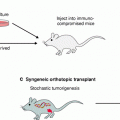Fig. 1
a The ROS and nuclear DNA damages induced by radiation can activate NFκB that in turn enters into the nucleus and binds to the promoter of HER2 gene causing its transactivation. The increased HER2 protein copies further activate NFκB activity thus accelerating the HER2-NFκB-HER2 loop, which is simplified and shown in b
8 Conclusion
Accumulating experimental evidence supports the existence of a subpopulation of cancer cells known as cancer stem cells (CSCs). These cells comprise a small portion of most tumors and are uniquely able to regenerate an entire tumor. This population of cells may express different cell surface markers than most other tumor cells; in breast cancer, some evidence suggests that CSCs exhibit a CD44+/CD24−/phenotype. In addition to their role as a progenitor population, CSCs appear to be especially resistant to anticancer therapies, including radiotherapy. The radio-resistance of CSCs appears to be mediated by both the activation of pro-survival pathways and the inhibition of pro-apoptotic pathways. Early data suggest that activation of the NFκB pathway is integral to radio-resistance: NFκB initiates a pro-survival pathway by enhancing DNA repair through the control of cell cycle checkpoints, and NFκB also contributes to radio-resistance through the inhibition of apoptosis. Importantly, the NFκB pathway is initiated by the HER2 signaling pathway, itself an important therapeutic target in breast cancer. There is emerging evidence that NFκB may feedback to enhance HER2 signaling, a positive feedback mechanism dubbed the HER2-NFκB-HER2 loop. The molecular mechanisms underlying CSC-related radio-resistance are not yet fully elucidated. It is hoped that clarification of these pathways will yield insights into the design of pharmaceuticals to overcome radio-resistance (and chemo-resistance) and render the all-important CSCs vulnerable to cytotoxic therapies.
References
Al-Hajj M (2007) Cancer stem cells and oncology therapeutics. Curr Opin Oncol 19:61–64PubMed
Al-Hajj M, Wicha MS, Benito-Hernandez A, Morrison SJ, Clarke MF (2003) Prospective identification of tumorigenic breast cancer cells. Proc Natl Acad Sci U S A 100:3983–3988CrossRefPubMedCentralPubMed
Baldwin AS (2001) Control of oncogenesis and cancer therapy resistance by the transcription factor NFkappaB. J Clin Invest 107:241–246CrossRefPubMedCentralPubMed
Brach MA, Hass R, Sherman ML, Gunji H, Weichselbaum R, Kufe D (1991) Ionizing radiation induces expression and binding activity of the nuclear factor kappa B. J Clin Invest 88:691–695CrossRefPubMedCentralPubMed
Britten CD (2004) Targeting ErbB receptor signaling: a pan-ErbB approach to cancer. Mol Cancer Ther 3:1335–1342PubMed
Cao N, Li S, Wang Z, Ahmed KM, Degnan ME, Fan M, Dynlacht JR, Li JJ (2009) NFkappaB-mediated HER2 overexpression in radiation-adaptive resistance. Radiat Res 171:9–21CrossRefPubMedCentralPubMed
Croker AK, Allan AL (2011). Inhibition of aldehyde dehydrogenase (ALDH) activity reduces chemotherapy and radiation resistance of stem-like ALDH(hi)CD44 (+) human breast cancer cells. Breast Cancer Res Treat. DOI 10.1007/s10549-10011-11692-y
Diehn M, Cho RW, Clarke MF (2009) Therapeutic implications of the cancer stem cell hypothesis. Semin Radiat Oncol 19:78–86CrossRefPubMedCentralPubMed
Dylla SJ, Beviglia L, Park IK, Chartier C, Raval J, Ngan L, Pickell K, Aguilar J, Lazetic S, Smith-Berdan S, Clarke MF, Hoey T, Lewicki J, Gurney AL (2008) Colorectal cancer stem cells are enriched in xenogeneic tumors following chemotherapy. PLoS ONE 3:e2428CrossRefPubMedCentralPubMed
Ginestier C, Hur MH, Charafe-Jauffret E, Monville F, Dutcher J, Brown M, Jacquemier J, Viens P, Kleer CG, Liu S, Schott A, Hayes D, Birnbaum D, Wicha MS, Dontu G (2007) ALDH1 is a marker of normal and malignant human mammary stem cells and a predictor of poor clinical outcome. Cell Stem Cell 1:555–567CrossRefPubMedCentralPubMed
Granville DJ, Carthy CM, Jiang H, Levy JG, McManus BM, Matroule JY, Piette J, Hunt DW (2000) Nuclear factor-kappaB activation by the photochemotherapeutic agent verteporfin. Blood 95:256–262PubMed
Stay updated, free articles. Join our Telegram channel

Full access? Get Clinical Tree






